How To Change Bar Chart To Histogram In Excel
Excel for Microsoft 365 Discussion for Microsoft 365 Outlook for Microsoft 365 PowerPoint for Microsoft 365 Excel for Microsoft 365 for Mac Word for Microsoft 365 for Mac Outlook for Microsoft 365 for Mac PowerPoint for Microsoft 365 for Mac Excel for the spider web Excel 2021 Word 2021 Outlook 2021 PowerPoint 2021 Excel 2021 for Mac Word 2021 for Mac Outlook 2021 for Mac PowerPoint 2021 for Mac Excel 2019 Word 2019 Outlook 2019 PowerPoint 2019 Excel 2019 for Mac Word 2019 for Mac Outlook 2019 for Mac PowerPoint 2019 for Mac Excel 2016 Discussion 2016 Outlook 2016 PowerPoint 2016 Excel 2016 for Mac Excel 2013 Excel for iPad Excel for iPhone Excel 2010 Excel 2007 More than...Less
A histogram is a column chart that shows frequency data.
Note:This topic only talks well-nigh creating a histogram. For information on Pareto (sorted histogram) charts, come across Create a Pareto chart.
-
Select your data.
(This is a typical example of data for a histogram.)
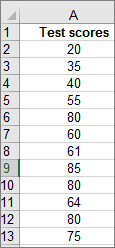
-
Click Insert > Insert Statistic Chart > Histogram.
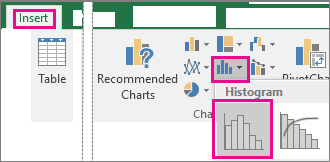
You tin also create a histogram from the All Charts tab in Recommended Charts.
Tips:
-
Apply the Design and Format tabs to customize the look of your chart.
-
If you don't see these tabs, click anywhere in the histogram to add together the Chart Tools to the ribbon.

-
Correct-click the horizontal axis of the chart, click Format Axis, and and then click Centrality Options.
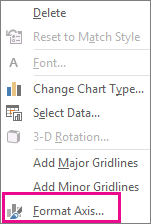
-
Use the information in the post-obit table to decide which options you desire to set in the Format Axis task pane.
Option
Clarification
By Category
Choose this option when the categories (horizontal axis) are text-based instead of numerical. The histogram will group the same categories and sum the values in the value axis.
Tip:To count the number of appearances for text strings, add together a column and fill it with the value "1", then plot the histogram and ready the bins to By Category.
Automatic
This is the default setting for histograms. The bin width is calculated using Scott's normal reference dominion.
Bin width
Enter a positive decimal number for the number of information points in each range.
Number of bins
Enter the number of bins for the histogram (including the overflow and underflow bins).
Overflow bin
Select this check box to create a bin for all values above the value in the box to the right. To change the value, enter a different decimal number in the box.
Underflow bin
Select this check box to create a bin for all values below or equal to the value in the box to the correct. To modify the value, enter a dissimilar decimal number in the box.
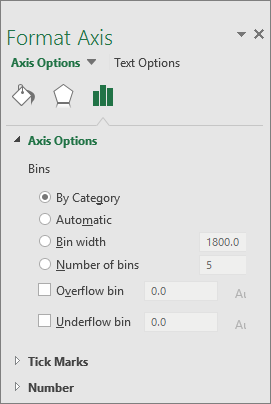
Automatic pick (Scott'southward normal reference rule)

Scott's normal reference dominion tries to minimize the bias in variance of the histogram compared with the data ready, while assuming usually distributed data.
Overflow bin pick

Underflow bin choice

-
Make sure you accept loaded the Assay ToolPak. For more information, see Load the Analysis ToolPak in Excel.
-
On a worksheet, blazon the input information in one cavalcade, calculation a label in the showtime jail cell if yous desire.
Be certain to utilise quantitative numeric data, like detail amounts or exam scores. The Histogram tool won't work with qualitative numeric data, like identification numbers entered every bit text.
-
In the adjacent cavalcade, type the bin numbers in ascending order, calculation a label in the first cell if you want.
Information technology's a good idea to utilize your own bin numbers considering they may exist more than useful for your analysis. If you don't enter any bin numbers, the Histogram tool volition create evenly distributed bin intervals by using the minimum and maximum values in the input range as offset and stop points.
-
Click Information > Information Analysis.

-
Click Histogram > OK.
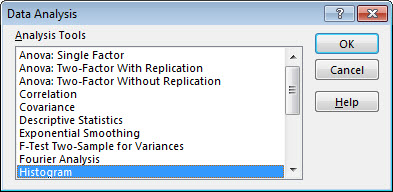
-
Under Input, exercise the post-obit:
-
In the Input Range box, enter the cell reference for the information range that has the input numbers.
-
In the Bin Range box, enter the cell reference for the range that has the bin numbers.
If you lot used column labels on the worksheet, yous can include them in the cell references.
Tip:Instead of inbound references manually, you lot can click
 to temporarily collapse the dialog box to select the ranges on the worksheet. Clicking the button again expands the dialog box.
to temporarily collapse the dialog box to select the ranges on the worksheet. Clicking the button again expands the dialog box.
-
-
If you lot included cavalcade labels in the cell references, check the Labels box.
-
Under Output options, choose an output location.
You tin put the histogram on the same worksheet, a new worksheet in the current workbook, or in a new workbook.
-
Check i or more than of the post-obit boxes:
Pareto (sorted histogram) This shows the data in descending guild of frequency.
Cumulative Percent This shows cumulative percentages and adds a cumulative pct line to the histogram chart.
Chart Output This shows an embedded histogram chart.
-
Click OK.
If you lot want to customize your histogram, you tin can modify text labels, and click anywhere in the histogram chart to use the Chart Elements, Chart Styles, and Chart Filter buttons on the right of the chart.
-
Select your data.
(This is a typical example of data for a histogram.)

-
Click Insert > Chart.

-
In the Insert Chart dialog box, under All Charts, click Histogram , and click OK.
Tips:
-
Utilise the Pattern and Format tabs on the ribbon to customize the look of your chart.
-
If y'all don't see these tabs, click anywhere in the histogram to add the Nautical chart Tools to the ribbon.

-
Right-click the horizontal axis of the nautical chart, click Format Axis, so click Axis Options.

-
Utilize the information in the following table to determine which options y'all want to set in the Format Centrality job pane.
Option
Description
Past Category
Choose this option when the categories (horizontal axis) are text-based instead of numerical. The histogram will group the same categories and sum the values in the value axis.
Tip:To count the number of appearances for text strings, add a cavalcade and fill information technology with the value "1", so plot the histogram and set the bins to By Category.
Automated
This is the default setting for histograms.
Bin width
Enter a positive decimal number for the number of information points in each range.
Number of bins
Enter the number of bins for the histogram (including the overflow and underflow bins).
Overflow bin
Select this check box to create a bin for all values to a higher place the value in the box to the right. To modify the value, enter a different decimal number in the box.
Underflow bin
Select this check box to create a bin for all values below or equal to the value in the box to the right. To change the value, enter a different decimal number in the box.

Follow these steps to create a histogram in Excel for Mac:
-
Select the data.
(This is a typical example of information for a histogram.)

-
On the ribbon, click the Insert tab, then click
 (Statistical icon) and under Histogram, select Histogram.
(Statistical icon) and under Histogram, select Histogram.
Tips:
-
Use the Chart Design and Format tabs to customize the look of your chart.
-
If you don't encounter the Chart Pattern and Format tabs, click anywhere in the histogram to add them to the ribbon.
To create a histogram in Excel 2011 for Mac, yous'll need to download a third-party add-in. See: I can't detect the Assay Toolpak in Excel 2011 for Mac for more than details.
In Excel Online, you tin view a histogram (a column chart that shows frequency data), simply you can't create it because it requires the Analysis ToolPak, an Excel add-in that isn't supported in Excel for the web.
If you lot have the Excel desktop application, y'all can employ the Edit in Excel button to open Excel on your desktop and create the histogram.

-
Tap to select your data.

-
If you're on a phone, tap the edit icon
 to show the ribbon. and then tap Home.
to show the ribbon. and then tap Home. -
Tap Insert > Charts > Histogram.
If necessary, you can customize the elements of the chart.
-
Tap to select your data.

-
If you're on a telephone, tap the edit icon
 to bear witness the ribbon, and so tap Home.
to bear witness the ribbon, and so tap Home. -
Tap Insert > Charts > Histogram.
To create a histogram in Excel, you provide 2 types of information — the data that you want to analyze, and the bin numbers that represent the intervals past which you want to measure the frequency. You must organize the data in two columns on the worksheet. These columns must contain the following data:
-
Input information This is the data that y'all want to analyze by using the Histogram tool.
-
Bin numbers These numbers represent the intervals that you lot want the Histogram tool to use for measuring the input data in the information analysis.
When you use the Histogram tool, Excel counts the number of data points in each data bin. A information point is included in a particular bin if the number is greater than the lowest bound and equal to or less than the greatest jump for the data bin. If you omit the bin range, Excel creates a set of evenly distributed bins between the minimum and maximum values of the input data.
The output of the histogram assay is displayed on a new worksheet (or in a new workbook) and shows a histogram table and a cavalcade chart that reflects the data in the histogram table.
Need more help?
You tin can always ask an expert in the Excel Tech Community or get support in the Answers community.
Come across Also
Create a waterfall chart
Create a Pareto nautical chart
Create a sunburst chart in Office
Create a box and whisker chart
Create a treemap nautical chart in Office
How To Change Bar Chart To Histogram In Excel,
Source: https://support.microsoft.com/en-us/office/create-a-histogram-85680173-064b-4024-b39d-80f17ff2f4e8
Posted by: benoitcabol2001.blogspot.com


0 Response to "How To Change Bar Chart To Histogram In Excel"
Post a Comment